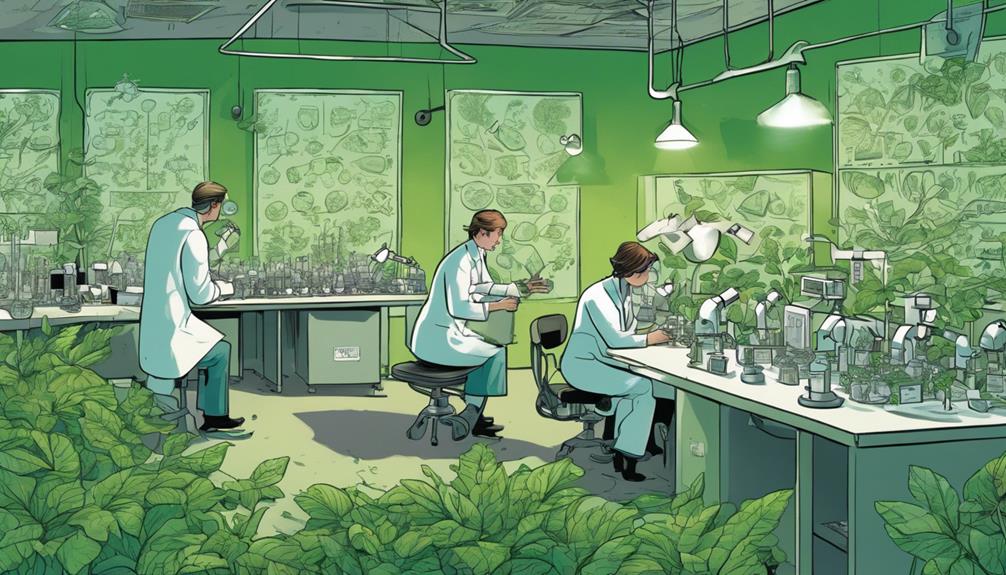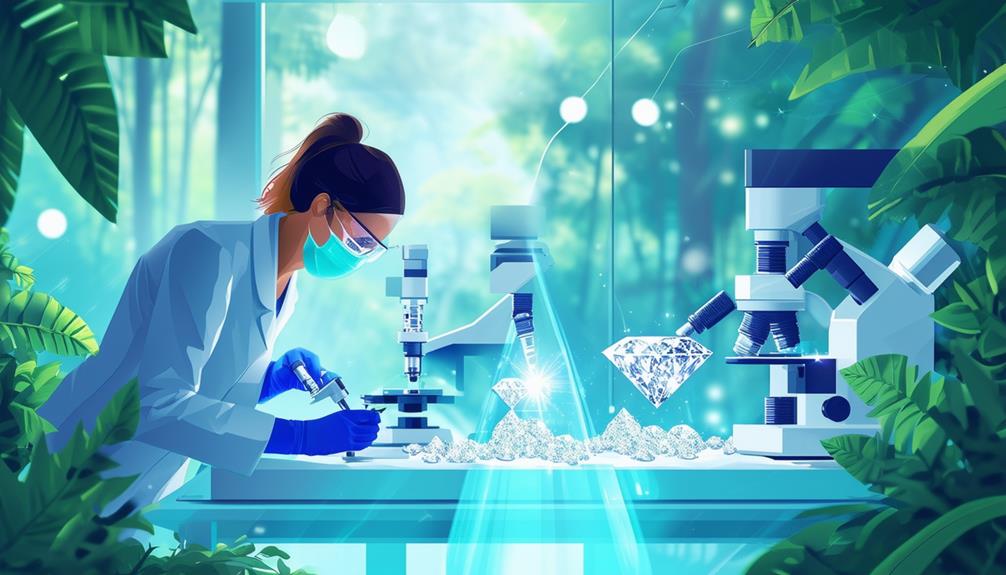Article Contents
Lab-created diamonds, produced using High Pressure High Temperature (HPHT) or Chemical Vapor Deposition (CVD) methods, possess the same visual and physical properties as natural diamonds. These diamonds contribute to environmental sustainability by reducing land degradation, minimising greenhouse gas emissions, and using less water compared to traditional diamond mining. Their production often utilises renewable energy sources and upholds strict ethical standards, making them an ethical option for environmentally conscious consumers.
The growing popularity of lab-grown diamonds highlights their role as both aesthetically pleasing and ecologically responsible choices. Further exploration through detailed quantitative analyses and case studies could provide more insights into their sustainability benefits.
Key Points
- Lab-grown diamonds help to reduce land degradation and preserve biodiversity, offering a stark contrast to the extensive environmental damage caused by traditional diamond mining.
- Unlike mined diamonds, lab-grown diamonds produce three times more greenhouse gas emissions, which represents a significant environmental impact that needs to be addressed.
- The production of synthetic diamonds often involves the use of renewable energy sources and advanced manufacturing techniques, demonstrating a commitment to environmental responsibility.
- By minimising water usage, synthetic diamonds improve their sustainability profile, further reducing their environmental impact compared to mined diamonds.
- Ethical standards enforced by regulatory bodies ensure that lab-grown diamonds adhere to both environmental and ethical criteria, maintaining their credibility in the market.
Understanding Lab-Created Diamonds
Lab-created diamonds, produced using advanced scientific methods, have the same chemical and physical characteristics as naturally formed diamonds. These synthetic diamonds are made using techniques such as High Pressure High Temperature (HPHT) or Chemical Vapor Deposition (CVD), which simulate the conditions in which natural diamonds develop. This manufacturing process ensures that lab-created diamonds possess the same beauty and durability as those mined from the earth.
As consumer awareness grows, lab-created diamonds are becoming more popular, partly because of their ethical origins. Buyers who value transparency and ethical considerations when making purchases are attracted to these diamonds because they avoid the ethical challenges often associated with diamond mining.
The market for lab-created diamonds is expanding, driven by their ethical appeal and comparatively lower costs when compared to mined diamonds. These factors make lab-created diamonds an appealing choice for consumers looking for affordable luxury and who want to make purchases that reflect their values. This change is impacting the diamond industry, promoting a consumption model that combines aesthetic enjoyment with ethical responsibility.
Environmental Benefits of Lab-Grown
Lab-grown diamonds offer significant environmental advantages by greatly reducing land disturbance, lowering carbon emissions, and using minimal water.
These diamonds are created in controlled environments that prevent the extensive ecological impact of conventional diamond mining.
By utilising renewable energy and advanced production techniques, the synthetic diamond industry is setting a new standard for environmental responsibility in the luxury goods sector.
Reduced Land Disruption
Lab-grown diamonds offer a significant environmental advantage by greatly reducing land disruption compared to traditional diamond mining. Unlike conventional methods that require extensive open-pit mining, which severely impacts natural habitats, the production of lab-grown diamonds is a non-invasive process that helps preserve ecosystems and supports biodiversity.
| Aspect | Traditional Mining | Lab-Grown Diamonds |
|---|---|---|
| Land Disruption | Extensive | Minimal |
| Ecosystem Impact | High disruption | Preserves ecosystems |
| Mining Technique | Invasive | Non-invasive |
Opting for lab-grown diamonds not only adds a touch of elegance but also aligns with commitments to environmental stewardship.
Reduce Carbon Emissions
Lab-grown diamonds significantly reduce carbon emissions compared to traditional mining methods, presenting a more eco-friendly option in the jewellery industry.
The Trucost report highlights that these synthetic diamonds decrease greenhouse gases, emphasising their contribution to sustainable practices. Utilising energy-efficient production processes, lab-grown diamonds align with carbon neutrality and ethical sourcing principles, reflecting technological progress.
As the demand for environmentally responsible luxury increases, these diamonds offer a viable solution for consumers prioritising both elegance and ecological integrity.
This shift towards eco-friendly luxury goods showcases a broader commitment to ethical and sustainable practices.
Minimal Water Usage
Synthetic diamonds significantly reduce water use compared to traditional diamond mining, making them an environmentally beneficial choice. These lab-grown diamonds are produced with advanced, sustainable practices that prioritise water conservation.
This efficient use of water not only supports environmental sustainability but also aligns with the ethical concerns of consumers seeking responsible products. Choosing synthetic diamonds helps foster the development of eco-friendly technologies in the jewellery industry.
Comparing Energy Use and Emissions
Lab-grown diamonds, while requiring significantly less energy to produce—between 250 to 750 kilowatt-hours per rough carat—than mined diamonds, generate three times the greenhouse gas emissions, according to a Trucost report. This finding highlights a crucial environmental dilemma, as the production of these synthetic diamonds, particularly in areas dependent on fossil fuels, leads to substantial emissions despite their energy efficiency.
Efforts to incorporate renewable energy sources in the production process of lab-grown diamonds could help reduce these emissions. Advances in technology may further decrease the environmental impact of these diamonds, aligning with the preferences of consumers who prioritise ethical and sustainable choices.
The Federal Trade Commission's recognition of lab-grown diamonds as equivalent to mined diamonds in terms of physical and aesthetic attributes supports their potential for contributing to a more sustainable future, provided there are continued improvements in reducing their production emissions.
Impact on Land and Biodiversity

The arrival of lab-created diamonds signifies a notable progress in sustainable practices, especially in reducing land degradation. By opting for artificial gemstones, the jewellery industry can help protect biodiversity and lessen habitat disruption compared to traditional mining methods.
These advancements not only support environmental conservation but also satisfy growing consumer demands for ethically sourced luxury items.
Reduced Land Degradation
Lab-created diamonds significantly reduce land degradation and enhance biodiversity conservation compared to traditional diamond mining. This is because traditional mining often causes severe ecological disruption by displacing large volumes of soil and damaging local ecosystems.
In contrast, synthetic diamonds are manufactured in controlled settings, which substantially lowers their environmental impact. This process does not involve excavating large areas, thus preserving natural habitats and maintaining biodiversity.
Adopting lab-grown diamonds promotes sustainable economic practices and adheres to ethical sourcing principles that prioritise environmental conservation. Consequently, consumers who choose lab-created diamonds not only symbolise their love and commitment but also support a more sustainable and responsible approach to using our planet's resources, benefiting future generations.
Benefits of Preserving Biodiversity
Choosing lab-created diamonds significantly aids in preserving biodiversity by reducing the environmental destruction often associated with traditional diamond mining. Consumers and producers who opt for these sustainable alternatives foster wildlife conservation and promote ethical sourcing.
The adoption of lab-grown diamonds decreases the exploitation of land, enabling ecosystems to flourish and perform their essential roles. This practice not only protects the natural habitats of numerous species but also preserves the environmental integrity of areas where diamonds are typically mined.
As the importance of ecosystem protection grows, selecting lab-created diamonds reflects a deeply responsible choice that aligns with the imperative to protect our planet's biodiversity and promote environmental stewardship.
Minimal Habitat Disruption
Lab-created diamonds significantly reduce habitat disruption compared to traditional diamond mining, which often involves extensive land excavation and deforestation. By avoiding these practices, synthetic diamonds offer a more sustainable alternative that promotes wildlife protection and ecosystem conservation. Here are some key points:
- Lab diamonds reduce biodiversity loss associated with conventional mining.
- They help preserve natural habitats by not requiring large areas of land.
- The technology involved minimises disturbance to wildlife and their habitats.
- It supports ecosystem conservation by limiting human impact.
- Lab-created diamonds help maintain ecological balance by preserving land resources.
Choosing lab-created diamonds supports environmental conservation efforts effectively.
The Role of Regulation and Certification

Regulation and certification are crucial in addressing ethical concerns within the diamond industry, ensuring sustainability and transparency for both mined and lab-created diamonds. Regulatory bodies enforce strict ethical standards that preserve the integrity of the industry, while certification processes, such as the Kimberley Process, verify diamonds as conflict-free, safeguarding natural resources and human rights.
Lab-grown diamonds undergo rigorous evaluation to ensure they meet stringent environmental and ethical standards, appealing to consumers who prioritise both luxury and environmental responsibility. These frameworks of oversight and verification not only maintain high ethical standards but also foster consumer trust by providing assurance that their diamond purchases are both socially and environmentally responsible.
Thus, regulation and certification serve as fundamental mechanisms that support the ethical procurement and sale of diamonds, enabling consumers to make informed choices that align with their values and contribute to the ethical stewardship of global resources. The importance of these systems extends beyond mere compliance; they enhance the overall value and reputation of the diamond industry by ensuring that every diamond's history is as commendable as its lustre.
Future Prospects in Diamond Synthesis
The projected increase in the lab-grown diamond market to $27.6 billion by 2023 highlights its significant impact on the jewellery industry. This growth is driven by advancements in diamond synthesis technology and initiatives aimed at sustainability, appealing to consumers seeking ethical options. The future of diamond synthesis promises developments that not only enhance the attractiveness of these gems but also promote environmental responsibility.
Key prospects in diamond synthesis include:
- Enhanced Quality and Size: Technological improvements are enhancing the gemological properties of lab-grown diamonds, rendering them virtually identical to mined diamonds.
- Customisation Flexibility: Consumers have the option to choose specific characteristics such as colour, clarity, and carat size, fulfilling the demand for personalised jewellery.
- Sustainability Efforts: Continued research focuses on minimising the environmental impact of diamond production, with a strong emphasis on using renewable energy sources and implementing recycling processes.
- Market Expansion: As acceptance of lab-grown diamonds increases, new markets are emerging worldwide, especially in regions influenced by strong ethical consumer preferences.
- Efficiency Improvements: Advances in production techniques are expected to reduce costs and shorten manufacturing times, making lab-grown diamonds more available to a broader audience.
These developments are crucial for the industry's ability to adapt to evolving market conditions and align with the growing preference for customisable and responsible luxury consumption.
Frequently Asked Questions
Are Lab-Grown Diamonds Actually Sustainable?
Lab-grown diamonds are often seen as a more sustainable choice as they usually use less energy and employ scalable production methods. These factors help reduce their environmental impact, providing a more eco-friendly option in the jewellery industry.
Is it more ethical to buy lab-grown diamonds?
Opting for lab-grown diamonds can be a more ethical choice as it avoids the human rights issues commonly associated with traditional diamond mining. Additionally, these diamonds typically have a lower environmental impact, aligning with values of sustainability and ethical responsibility.
Is there any reason not to buy a lab-grown diamond?
Some reasons to reconsider purchasing a lab diamond include its potentially lower resale value compared to mined diamonds and its less certain long-term investment potential. These factors may affect the financial benefits traditionally associated with natural diamonds.
Are Lab-Created Stones Better for the Environment?
Lab-created stones typically have a smaller environmental footprint compared to those obtained through traditional mining methods. They use less energy and generate less waste, making them a greener choice. However, they still have environmental drawbacks, as their production requires a considerable amount of energy. Nevertheless, lab-created stones are a more sustainable option as they help to limit land disturbance and decrease the pollution linked to standard mining practices.
Summary
Lab-created diamonds offer a sustainable alternative to traditional diamond mining, significantly reducing environmental degradation. By using up to 85% less water than mined diamonds, these synthetic gems help to preserve natural resources.
As awareness and demand for environmentally friendly practices increase, the production of lab-created diamonds is in line with the trend towards ethical consumerism in the jewellery industry.
Continuous advancements in technology and regulation not only improve environmental advantages but also boost the appeal of lab-created diamonds worldwide.

